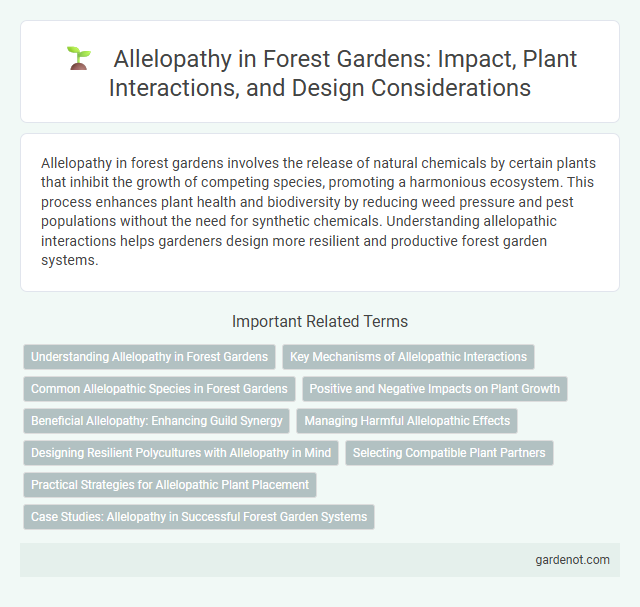Allelopathy in forest gardens involves the release of natural chemicals by certain plants that inhibit the growth of competing species, promoting a harmonious ecosystem. This process enhances plant health and biodiversity by reducing weed pressure and pest populations without the need for synthetic chemicals. Understanding allelopathic interactions helps gardeners design more resilient and productive forest garden systems.
Understanding Allelopathy in Forest Gardens
Allelopathy in forest gardens involves the release of biochemicals by certain plants that influence the growth, survival, and reproduction of neighboring species. This natural process can enhance biodiversity by suppressing weeds and promoting beneficial plant interactions, optimizing plant health and productivity. Understanding allelopathy helps forest gardeners select compatible species, improving overall ecosystem balance and resilience.
Key Mechanisms of Allelopathic Interactions
Allelopathic interactions in forest gardens primarily involve the release of biochemicals called allelochemicals from plant roots, leaves, or decomposing litter, which influence the growth and development of neighboring plants. Key mechanisms include the inhibition of seed germination, suppression of root elongation, and alteration of nutrient uptake in target species through compounds such as phenolics, terpenoids, and alkaloids. These biochemical processes contribute to plant competition dynamics, soil microbial community shifts, and overall ecosystem balance within forest garden systems.
Common Allelopathic Species in Forest Gardens
Common allelopathic species in forest gardens include black walnut (Juglans nigra), eucalyptus (Eucalyptus spp.), and acacia (Acacia spp.), which release biochemical compounds into the soil that inhibit the growth of surrounding plants. These allelochemicals such as juglone from black walnut or cineole from eucalyptus affect seed germination and root development, shaping plant community dynamics within the garden ecosystem. Proper species selection and spatial arrangement mitigate negative impacts, enhancing biodiversity and productivity in forest garden design.
Positive and Negative Impacts on Plant Growth
Allelopathy in forest gardens influences plant growth by releasing biochemicals that can either inhibit or stimulate neighboring plants. Positive impacts include enhanced soil fertility and natural pest suppression, promoting diverse plant health and resilience. Negative effects arise when certain species emit toxins that reduce seed germination and stunt growth, challenging the balance of plant communities.
Beneficial Allelopathy: Enhancing Guild Synergy
Beneficial allelopathy in forest gardens promotes positive chemical interactions among plants, boosting guild synergy and overall ecosystem health. Certain species release natural compounds that enhance nutrient availability, suppress pests, and support growth of companion plants, creating a self-sustaining environment. This dynamic improves biodiversity, increases productivity, and reduces the need for artificial inputs, optimizing forest garden resilience.
Managing Harmful Allelopathic Effects
Managing harmful allelopathic effects in forest gardens involves selecting species that minimize negative chemical interactions and implementing practices such as regular mulching and controlled pruning to reduce the accumulation of allelochemicals. Introducing diverse plant varieties with complementary traits can help buffer sensitive species from toxic compounds released by allelopathic plants like walnut or eucalyptus. Monitoring soil health and promoting microbial activity through organic amendments also enhances the breakdown of allelochemicals, improving overall plant growth and ecosystem resilience.
Designing Resilient Polycultures with Allelopathy in Mind
Allelopathy plays a crucial role in designing resilient polycultures by leveraging plants that naturally release biochemicals to suppress weeds and pests, enhancing forest garden health. Incorporating species like black walnut (Juglans nigra) or certain allelopathic cover crops can create self-regulating ecosystems that reduce reliance on synthetic inputs. Strategic plant selection based on allelopathic interactions promotes biodiversity, soil fertility, and overall system stability in forest garden design.
Selecting Compatible Plant Partners
Allelopathy plays a crucial role in selecting compatible plant partners for a forest garden by influencing which species release chemical compounds that can inhibit or promote the growth of neighboring plants. Understanding allelopathic interactions helps gardeners combine species like black walnut, which produces juglone affecting sensitive plants, with tolerant companions such as garlic or elderberry. This strategy enhances plant health and biodiversity, ensuring a productive and sustainable forest garden ecosystem.
Practical Strategies for Allelopathic Plant Placement
Strategic placement of allelopathic plants like black walnut, eucalyptus, or sunflowers within a forest garden minimizes their inhibitory effects on neighboring species by maintaining adequate spacing and using buffer plants such as nitrogen-fixing legumes. Incorporating mulch from allelopathic plants in designated areas reduces soil toxicity risks while enhancing weed suppression. Monitoring plant growth patterns and soil health ensures balanced biodiversity and sustained productivity in allelopathic-rich garden zones.
Case Studies: Allelopathy in Successful Forest Garden Systems
Case studies of allelopathy in successful forest garden systems reveal how certain plants naturally suppress weeds and pests through chemical interactions, enhancing overall ecosystem health. For example, black walnut (Juglans nigra) produces juglone, which inhibits growth of competing species, supporting understory diversity and soil quality. Incorporating allelopathic species strategically helps optimize plant spacing and biodiversity in forest gardens, promoting sustainable productivity.
Allelopathy Infographic

 gardenot.com
gardenot.com